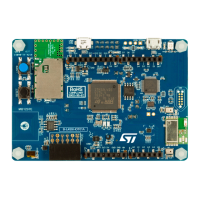DocID029937 Rev 2 9/22
AN4943 LCD-TFT display on FSMC
21
3.3 Controlling the D/CX signal with STM32L496xx/L4A6xx/
L4Rxxx/L4Sxxx microcontrollers
The D/CX signal of the DBI protocol is used to distinguish the commands (when D/CX = 0)
from the data (when D/CX = 1) transfers.
There are 2 ways to control the 'Data/Command control' (D/CX) signal:
1. By using a dedicated GPIO:
– Setting the 'Data/Command control' signal in "command mode" (setting the GPIO
connected to the D/CX signal to '0' by software)
– Sending the command
– Setting the 'Data/Command control' signal in "data mode" (setting the GPIO
connected to the D/CX signal to '1' by software)
– Sending the data (frame buffer)
2. By using an address bit of the FSMC address bus:
– Reserving a “low level” address in the memory map for the command transfer
– Reserving the higher memory map range for the data transfer
When using the DMA2D to access the LCD-TFT display on FSMC interface, it is important
to remember that even if the LCD-TFT display target is at a fixed address, the Chrom-ART
Accelerator™ (DMA2D) increments the address bus of the transmitted data at each access
(like a memory to memory access). Thus the FSMC address bus is incremented to cover
the full data range address in the memory map.
Figure 3. Memory map for LCD-TFT display access
Using the 2
nd
option “an address bit of the FSMC address bus” makes the software simpler
than using the 1
st
option with a dedicated GPIO, but it requires using the “high level”
address to control the ‘data or command select signal’.
• The user cannot use for example the FSMC address LSB bit (FSMC_A0) to control the
‘data or command select signal’
• The user must use a “high enough” FSMC address bit in order to keep for this bit the
same value during the whole image frame buffer transfer.
0xxxxx0000
‘High level’ address
command @
data @ range
MSv44236V1

